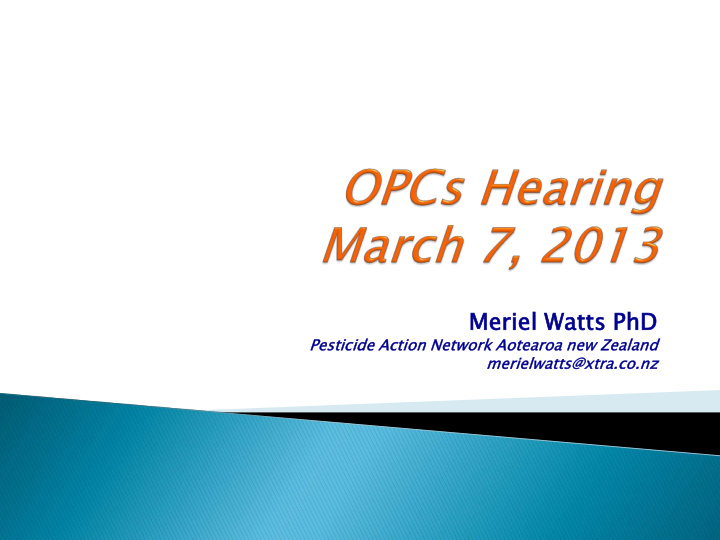



Merie iel l Watts ts PhD Pestic sticide ide Action on Network rk Aotearoa aroa new Zeal alan and meri rielw lwat atts ts@x @xtra. tra.co co.nz
1.OPCs as a whole Human health a) Environment b) Uses and alternatives c) 2. Chlorpyrifos Human health a) POPS characteristics b) Uses and alternatives c)
EPA-commissioned overview of epidemiological studies found the following associations with exposure to OPCs: Probable neurodevelopmental effects Probable neurobehavioural, neurophysiological, and neurological effects Possible increased cancer risk .
“ One farmer ends his life every 2 weeks ” (Straight Furrow Feb 12 th ) Elevated association of OP exposure with suicide (London et al 2012) 2-fold increased risk of suicides with exposure to chlorpyrifos (Lee et al 2007b )
Chlorpyrifos being reviewed again by EU and US for this effect Statement by the American Academy of Pediatrics in their journal, Pediatrics: “ Prospective contemporary birth cohort studies in the United States link early-life exposures to organophosphate insecticides with reductions in IQ and abnormal behaviors associated with attention-deficit/ hyperactivity disorder and autism.” And “ Recommendation to government: advance less toxic pesticide alternatives”.
EPA: ◦ In general the risk of the OPCs to the environment are high (response to Waikato Tainui River Trust) ◦ Risks indentified for the aquatic environment are likely to be underestimated because it didn’t take into account run off and leaching (response to WTRT) PAN: ◦ Mass killing of birds with diazinon granules is simply not acceptable regardless of whether there are alternatives or not ◦ EPA means Environmental Protection Authority
Dairy NZ submission – “ OPCs should only be used if there are no alternatives available ” EPA: alternatives are being used by large-scale growers But focuses only on biological controls And doesn’t intend to limit uses where alternatives are available PAN: EPA and growers must also acknowledge biopesticides and sustainable management practices as viable effective alternatives ◦ has demonstrated very clearly there are alternatives to all uses of chlorpyrifos – but that has not been acknowledged, and there is no proposal to limit use of chlorpyrifos ◦ That the EPA considers the OPCs should continue be used because some users dispute the availability of alternatives when other growers are clearly using them already, is not good enough.
Chlorpyrifos has a greater adverse effect on neural cell replication and is inherently more toxic to the developing brain than the more acutely toxic organophosphates such as diazinon and parathion (Slotkin et al 2006) " These findings indicate that prenatal exposure to the insecticide chlorpyrifos not only increases the likelihood of developmental delay, but may have long-term consequences for social adjustment and academic achievement. Relatively speaking, the insecticide effects reported here are comparable to what has been seen with exposures to other neurotoxicants such as lead and tobacco smoke ." (Rauh et al 2006)
Prenatal exposure to chlorpyrifos is altering children’s brain structure, the effects being visible at least 11 years after birth. (Rauh et al 2012) CAL EPA (2010) – set child-specific reference dose 0.0001 mg/kg/day [cf EPA ADI = 0.003] because: there is now evidence that chlorpyrifos directly targets events that are specific to the developing brain and that are not related to inhibition of cholinesterase Yet the NZ EPA insists on looking only at effects on cholinesterase
EPA failed to address POPS properties Chlorpyrifos meets Stockholm Convention criteria ◦ persistence - in soil, pond sediment, creek sediment, surface water ◦ bioaccumulation – Kow and BCF studies – and only one of these need be meet ◦ long-range transport - widespread contamination in the Arctic and one of the most common pollutants along with endosulfan
Dow - ◦ measured and estimated BCFs do not show bioaccumulation Dow - did not dispute that ◦ the Kow shows bioaccumulation potential, and this is sufficient for Stockholm ◦ chlorpyrifos is persistent ◦ found throughout the Arctic BUT - EPA has not addressed this! Although classification web page says chlorpyrifos is bioaccumulative in fish What happens when chlorpyrifos is listed under Stockholm ? Reassess again? Should be phased-out
Dow: ◦ does not support home garden, indoor/outdoor domestic or industrial use because of concerns about exposure to children, pests, wildlife and the environment; and they want such uses cancelled ◦ “ Use of chlorpyrifos has dropped in the last 20 and particularly the last 5 years as growers move to products that fit with more “green’ spray programmes. ” ◦ “ Over the last 20 years chlorpyrifos has been largely phased out of horticulture and replaced by more modern products ”. PAN: ◦ has demonstrated very clearly there are alternatives, including safer chemicals, biopesticides, biological control and sustainable management practices, to all uses of chlorpyrifos ◦ Phase it out - 3-5 years
All OPCs pose unacceptable risks to human health and the environment Retain uses as per PAN submission, with controls as per PAN submission Phase out all home and garden use, including no approved handler use Phase-out as per PAN submission; except Chlorpyrifos 3-5 years Users are not aware of the real effects of OPs beyond acute poisoning Many growers seem to be unaware of the numerous alternatives They need assistance – there should be recommendations on the provision of information on alternatives, especially nonchemical, to growers
Recommend
More recommend